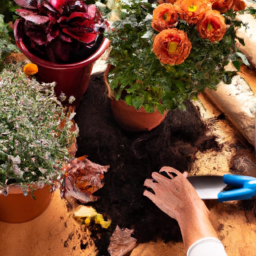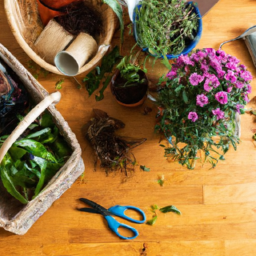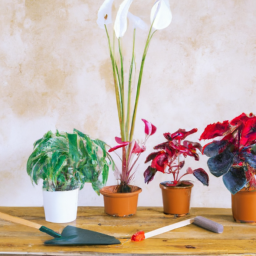
Autumn is just around the corner, and that means it’s time to start preparing our indoor gardens for the change in season. As the temperatures drop and the days get shorter, our beloved plants need a little extra care to thrive during the autumn months. Whether you’re a seasoned plant enthusiast or just starting out with your indoor garden, this blog post will guide you through the essential steps of autumn plant prep. From adjusting watering schedules to providing adequate lighting, we’ll cover all the tips and tricks to ensure your plants stay healthy and vibrant throughout the autumn season. So, grab your gardening gloves and let’s dive into the world of autumn plant prep: getting your indoor garden ready!
Choosing the Right Indoor Plants for Autumn: Essential Tips and Recommendations
Welcome to our comprehensive guide on getting your indoor garden ready for autumn! As the seasons change, it’s important to prepare your plants for the transition to ensure they thrive during the colder months. In this article, we will walk you through the process of choosing the right indoor plants for autumn, providing you with essential tips and recommendations along the way.
Understanding Your Indoor Environment
Before diving into the selection process, it’s crucial to understand the conditions of your indoor environment. Different plants have different light, temperature, and humidity requirements. Assess the available space in your home, the amount of natural light it receives, and the average temperature and humidity levels.
If your home has limited natural light, consider plants that can thrive in low-light conditions, such as snake plants, pothos, or ZZ plants. On the other hand, if your home receives ample sunlight, you can opt for plants that require bright, indirect light like succulents, peace lilies, or spider plants.
Temperature is another important factor to consider. Most indoor plants prefer temperatures between 60-75°F (15-24°C). Avoid placing your plants near drafty windows or heating vents, as sudden temperature fluctuations can stress them. Additionally, monitor the humidity levels in your home. If your indoor environment is dry, consider incorporating plants that thrive in drier conditions, such as cacti or air plants.
Choosing the Right Plants
Now that you have a better understanding of your indoor environment, it’s time to select the right plants for autumn. Here are some recommendations:
1. Snake Plant (Sansevieria)
The snake plant is a popular choice for indoor gardening due to its low maintenance requirements and air-purifying qualities. It can tolerate a wide range of light conditions, from low to bright indirect light, making it an excellent choice for different areas of your home. Snake plants are also known for their ability to convert carbon dioxide into oxygen at night, making them ideal bedroom companions.
2. Peace Lily (Spathiphyllum)
The peace lily is another versatile plant that can thrive in various light conditions, from low to bright indirect light. It’s known for its beautiful white flowers and its ability to improve indoor air quality. Peace lilies prefer slightly higher humidity levels, making them great for bathrooms or kitchens.
3. Spider Plant (Chlorophytum comosum)
The spider plant is an excellent choice for beginners. It’s incredibly resilient and can tolerate a wide range of light conditions, from low to bright indirect light. Spider plants produce long, arching leaves adorned with small plantlets, adding a touch of green to any room. They also help purify the air by removing toxins like formaldehyde and carbon monoxide.
Caring for Your Indoor Plants in Autumn
Now that you have chosen the right plants for your indoor garden, it’s essential to provide them with proper care during autumn. Here are some tips:
1. Adjust watering frequency:
As the temperature drops and daylight hours decrease, your plants’ water requirements will change. Monitor the moisture levels of the soil and adjust your watering frequency accordingly. Be careful not to overwater, as this can lead to root rot.
2. Maintain consistent temperatures:
Avoid exposing your plants to extreme temperature fluctuations. Keep them away from drafty windows or heating vents. Maintain a consistent temperature range to prevent stress and damage to your plants.
3. Monitor humidity levels:
As the air becomes drier during autumn, consider using a humidifier or placing a tray of water near your plants to increase humidity levels. This is especially important for plants that thrive in higher humidity environments.
4. Prune and fertilize:
Regularly inspect your plants for any dead or yellowing leaves and remove them to promote healthy growth. Additionally, consider fertilizing your plants with a balanced indoor plant fertilizer to provide them with essential nutrients during the autumn months.
By following these steps and providing the right care, you can ensure that your indoor garden thrives throughout autumn. Remember to adjust your plant care routine as the seasons change, and enjoy the beauty of nature indoors!

Creating a Cozy and Inviting Indoor Garden for the Autumn Season
Introduction
As the leaves outside start to change color and the air becomes crisp, it’s time to prepare your indoor garden for the autumn season. Creating a cozy and inviting space not only enhances the beauty of your home but also provides a soothing environment to relax and unwind. In this guide, we will take you through the step-by-step process of getting your indoor garden ready for autumn, ensuring your plants thrive during this time of transition.
1. Assessing Your Indoor Garden
Before diving into autumn preparations, it’s crucial to assess the current state of your indoor garden. Take a close look at each plant and evaluate its health, growth, and any potential issues. Look for signs of pests, diseases, or nutrient deficiencies. Remove any dead or dying leaves, flowers, or stems to promote healthier growth.
Consider the available space and lighting conditions in your indoor garden. Some plants may need to be relocated to areas with better natural light or supplemented with artificial grow lights. Make a list of the plants that require special attention or care during the autumn season.
Once you have assessed your indoor garden, you can proceed to the next step of preparing your plants for the autumn season.
2. Pruning and Trimming
Autumn is the perfect time to prune and trim your indoor plants. This process helps remove dead or damaged branches, encourages new growth, and maintains the desired shape and size of your plants. Use clean and sharp pruning shears to avoid causing unnecessary stress or damage to your plants.
Start by removing any dead or yellowing leaves. Trim back overgrown branches to promote a more compact and bushy growth habit. Pay attention to the specific pruning requirements of each plant, as some may require more extensive pruning while others only need light trimming.
Remember to sanitize your pruning tools between plants to prevent the spread of diseases. After pruning and trimming, give your plants a gentle wipe-down with a damp cloth to remove any dust or debris.
3. Adjusting Watering and Fertilizing
As the autumn season approaches, the watering and fertilizing needs of your indoor plants may change. Monitor the moisture levels in the soil and adjust your watering schedule accordingly. Most plants require slightly less water during the cooler months, so be cautious not to overwater.
Consider using a moisture meter to accurately determine when your plants need watering. This handy tool eliminates the guesswork and prevents both underwatering and overwatering. Remember to water your plants thoroughly, allowing the excess water to drain out of the pots.
Additionally, adjust your fertilizing routine to match the slowed growth of your plants during autumn. Reduce the frequency of fertilization and use a balanced formula to provide essential nutrients without encouraging excessive growth. Follow the specific fertilizing recommendations for each plant, as some may have unique requirements.
4. Introducing Autumn Decor
One of the joys of the autumn season is the opportunity to decorate your indoor garden with cozy and inviting elements. Consider adding seasonal touches to enhance the ambiance and create a warm atmosphere.
Start by incorporating fall-colored foliage, such as red, orange, and yellow plants, to bring a touch of autumnal beauty to your garden. Potted mums, marigolds, and crotons are excellent choices for vibrant autumn colors. You can also introduce decorative gourds, pumpkins, or dried corn husks to add a rustic charm.
Don’t forget to include some scented candles or essential oil diffusers with autumn-inspired fragrances like cinnamon, vanilla, or apple. These delightful scents will further enhance the cozy atmosphere of your indoor garden.
Conclusion
Preparing your indoor garden for the autumn season is an exciting and rewarding process. By assessing your plants, pruning and trimming, adjusting watering and fertilizing, and introducing autumn decor, you can create a cozy and inviting space that brings the beauty of the season indoors. Remember to provide your plants with love, care, and attention throughout the autumn months, and they will reward you with their vibrant colors and lush foliage. Happy gardening!

Essential Autumn Plant Care: Preparing Your Indoor Garden for the Colder Months
Gardening enthusiasts know that autumn is a crucial time for preparing indoor gardens for the colder months ahead. As the leaves start to change their colors and the temperature begins to drop, it is essential to take certain steps to ensure the health and vitality of your indoor plants. In this guide, we will walk you through the essential autumn plant care tasks that will help your indoor garden thrive during the colder months.
Assessing Plant Health
The first step in preparing your indoor garden for autumn is to assess the health of your plants. Take a close look at each plant, examining the leaves, stems, and overall appearance. Look for any signs of pests, diseases, or nutrient deficiencies. If you notice any issues, address them promptly to prevent further damage.
Trimming and pruning are also crucial tasks during this time. Remove any dead or dying leaves, branches, or flowers to promote healthy growth. Pruning also helps improve the plant’s overall shape and encourages new growth. Remember to use clean and sharp tools to avoid causing unnecessary stress to your plants.
Furthermore, it’s a good idea to repot any plants that have outgrown their current containers. This allows them to have enough space for their roots to grow and ensures proper nutrient absorption. Choose containers with good drainage and use a high-quality potting mix suitable for the specific needs of each plant.
Adjusting Light and Temperature
As the days get shorter and sunlight becomes scarce, it is essential to adjust the lighting conditions for your indoor plants. Move them closer to windows or provide supplemental artificial light to ensure they receive the necessary amount of light. Consider using grow lights specifically designed for indoor gardening to provide the right spectrum of light for optimal growth.
Temperature is another critical factor to consider during autumn. Most indoor plants thrive in temperatures between 60-75°F (15-24°C). Avoid placing your plants near drafty windows or doors, as cold air can damage them. If necessary, use a space heater or insulation to maintain a consistent temperature in the room where your indoor garden is located.
Humidity levels tend to drop during the colder months, so it’s vital to provide adequate humidity for your plants. You can increase humidity by using a humidifier or placing a tray filled with water near your plants. Grouping plants together can also help create a microclimate with higher humidity.
Adjusting Watering and Fertilizing
Autumn brings changes in plant growth and water requirements. As the temperature drops, plants tend to grow slower, and their water needs decrease. Adjust your watering schedule accordingly and avoid overwatering, as it can lead to root rot and other moisture-related issues. Always check the moisture level in the soil before watering and ensure proper drainage to prevent waterlogging.
Fertilizing is equally important during this time. While some plants may require less fertilizer or even a complete break, others may benefit from a slow-release fertilizer that provides essential nutrients over a more extended period. Research the specific needs of each plant in your indoor garden and choose a suitable fertilizer accordingly.
Additionally, consider adding organic matter, such as compost or well-rotted manure, to the soil. This enriches the soil and improves its structure, promoting healthier root growth and overall plant vitality.
In conclusion, autumn plant care is an essential part of maintaining a thriving indoor garden. By assessing plant health, adjusting lighting and temperature, and adapting watering and fertilizing practices, you can ensure your plants are well-prepared for the colder months ahead. Remember to provide regular care and attention to your indoor garden throughout autumn and enjoy the beauty and benefits of a flourishing indoor oasis.
Let’s bring it all home
As the leaves start to change color and the weather cools down, it’s time to give some attention to your indoor garden and prepare it for the autumn season. With a little bit of planning and care, you can ensure that your plants thrive throughout the fall and winter months.
First, take some time to evaluate the condition of your plants. Look for any signs of pests or diseases, and remove any dead or yellowing leaves. This will not only improve the overall appearance of your indoor garden but also prevent the spread of any potential problems. Next, consider the lighting needs of your plants. As the days get shorter, you may need to provide additional artificial light to ensure that your plants receive enough light for healthy growth. Consider investing in grow lights or positioning your plants near windows that receive ample sunlight. Additionally, adjust the temperature and humidity levels in your home to create an optimal environment for your plants. Most indoor plants prefer temperatures between 65-75°F (18-24°C) and humidity levels around 40-60%. Using a humidifier or placing a tray of water near your plants can help maintain the right humidity levels. Finally, don’t forget to adjust your watering routine. With cooler temperatures and less sunlight, your plants will require less water. Check the soil moisture regularly and only water when the top inch of soil feels dry. Overwatering can lead to root rot and other issues, so be mindful of the watering needs of each plant in your indoor garden. By following these simple steps, you can ensure that your indoor garden thrives throughout the autumn season and beyond.
Here are some FAQs you’d be interested in:
Q1: When should I start preparing my indoor garden for autumn?
A1: It’s best to start preparing your indoor garden for autumn a few weeks before the season begins. This will give your plants enough time to adjust to any changes you make and ensure they are ready for the cooler temperatures and shorter daylight hours.
Q2: What steps should I take to prepare my indoor garden for autumn?
A2: To prepare your indoor garden for autumn, you should start by checking the condition of your plants. Remove any dead or dying leaves, trim back overgrown branches, and repot any plants that have outgrown their current pots. Additionally, consider adjusting the watering schedule and reducing fertilization as plants tend to slow down their growth during this season.
Q3: How can I ensure my indoor plants get enough sunlight during autumn?
A3: As the days get shorter during autumn, it’s important to ensure your indoor plants still receive enough sunlight. Place your plants near windows that receive the most sunlight during the day. You can also rotate them regularly to expose all sides to sunlight. If natural light is limited, consider using artificial grow lights to supplement the light your plants receive.
Q4: Should I adjust the watering schedule for my indoor plants during autumn?
A4: Yes, you should adjust the watering schedule for your indoor plants during autumn. As the weather cools down, plants tend to require less water. Check the soil moisture regularly and only water when the top inch of soil feels dry. Be careful not to overwater as this can lead to root rot. Remember, it’s always better to underwater than overwater.
Q5: Are there any specific pests or diseases I should watch out for during autumn?
A5: Yes, certain pests and diseases become more prevalent during autumn. Keep an eye out for common indoor plant pests like spider mites, aphids, and fungus gnats. Regularly inspect your plants for any signs of infestation such as yellowing leaves, webbing, or small flying insects. If you notice any issues, promptly treat them with appropriate organic or chemical solutions to prevent further damage to your indoor garden.

James Wong is a renowned ethnobotanist, plant scientist, and local television presenter. With a passion for demystifying plant science, he is known for translating complex botanical concepts into practical advice for everyday plant enthusiasts. James’s expertise spans from traditional gardening to cutting-edge plant technologies, making his insights accessible and informative.


